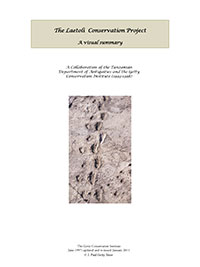A Visual Summary

Getty Conservation Institute
Revised 2011
Download PDF Low resolution (6.3MB)
Download PDF High resolution (11.8MB)
The Pliocene site of Laetoli, which preserves both hominid and faunal tracks, has immense scientific value, particularly for understanding human evolution. The trackway at Site G, fortuitously preserved within layers of volcanic tuff, offers unique evidence of bipedalism in hominids from 3.6 million years ago. Excavated by Mary Leakey in 1978–79, the trackway was documented and then reburied underneath a mantle of soil and lava boulders. Soon after, acacia trees and other vegetation took root in the burial fill, raising concerns about the survival of the trackway. In 1993 this concern led to a joint Getty Conservation Institute–Government of Tanzania project to conserve the trackway.
The visual summary tells the story of the Hominid Trackway at Laetoli project from 1992 to 1998 mainly through photographs, graphics and extended captions, and includes a brief mention of developments subsequent to the completion of the project in 1998.
How to Cite this Work
Getty Conservation Institute. 2011. The Laetoli Conservation Project: A Visual Summary: A Collaboration of the Tanzanian Department of Antiquities and the Getty Conservation Institute (1993-1998). Rev. ed. Los Angeles: Getty Conservation Institute. http://hdl.handle.net/10020/gci_pubs/laetoli_visual_summary
|
||||||||||||||||||||||||||||||||||||||||||||||